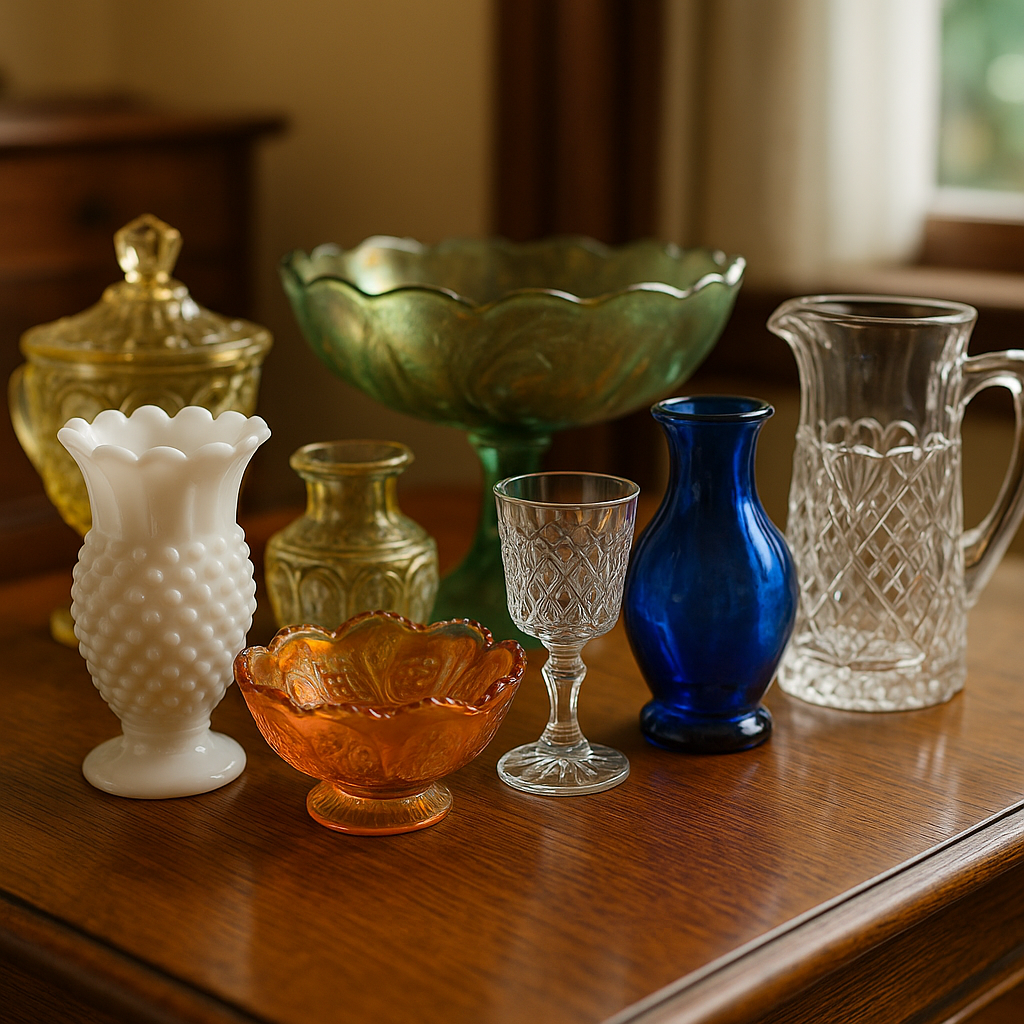Collectible glass has captivated vintage lovers for generations. Whether you’re a seasoned antique dealer or a new enthusiast browsing estate sales, understanding the different types of collectible glass is essential for curating a meaningful and valuable collection. From the opalescent shine of carnival glass to the charming simplicity of milk glass, vintage glassware offers a fascinating glimpse into design history—and an opportunity to bring timeless beauty into your home.
In this guide, we’ll break down the most popular types of collectible glass, including key characteristics, history, and tips for identifying authentic pieces. Whether you're decorating with vintage glass or building a collection for resale, this article will give you the knowledge to spot quality finds and shop with confidence.
1. Depression Glass
Notable patterns:
- Cameo
- Mayfair
- Princess
- Royal Lace
Why it’s collectible:
Despite being mass-produced, many patterns are now rare. Collectors seek matching sets, specific patterns, and hard-to-find colors.
Pro Tip: Hold the piece up to the light—real Depression glass often shows bubbles or imperfections due to its fast, inexpensive production.
2. Milk Glass
Milk glass is an opaque or translucent white glass, first popularized in the 19th century and revived in the mid-20th century. Its milky color and smooth finish make it especially versatile for both vintage décor and floral arrangements.
Popular makers:
- Westmoreland
- Fenton
- Anchor Hocking
Why it’s collectible:
Affordable and timeless, milk glass adds a clean, elegant touch to farmhouse and mid-century interiors. Collectors often seek hobnail patterns or pedestal vases.
Pro Tip: Look for marked bottoms to identify the maker and age, especially Westmoreland’s “W” inside a circle.
3. Carnival Glass
Carnival glass is known for its iridescent sheen that shimmers in hues of purple, gold, and blue. Produced from the early 1900s through the 1930s (and later revived), this pressed glass was given away at carnivals—hence the name.
Common colors:
- Marigold
- Amethyst
- Cobalt Blue
- Emerald Green
Why it’s collectible:
Its eye-catching finish and historical significance make carnival glass a favorite among collectors. Pieces like punch bowls, serving trays, and vases are especially sought after.
Pro Tip: Early carnival glass is heavier and more vibrant than reproduction pieces. Check for maker’s marks and pay attention to pattern details.
4. Elegant Glass
Elegant glass is the upscale cousin of Depression glass. Produced between the 1920s and 1950s, it was hand-finished and often etched, cut, or gilded. Makers like Heisey, Cambridge, and Fostoria created refined pieces for upper-class homes.
Key features:
- Polished bases
- Detailed patterns
- Crystal-clear or pastel-colored finishes
Why it’s collectible:
Elegant glassware offers both beauty and craftsmanship. Its high quality makes it a standout in any display or table setting.
Pro Tip: Examine the bottom for clarity and polish—elegant glass is smooth, unlike the rougher edges of Depression glass.
5. Art Glass
Art glass refers to hand-crafted, one-of-a-kind pieces often made by individual artisans or high-end glasshouses like Murano (Italy), Blenko (USA), or Loetz (Austria). These pieces can be sculptural, abstract, or highly decorative.
Popular styles:
- Mid-century modern forms
- Abstract vases
- Paperweights
- Swirl or bubble inclusions
Why it’s collectible:
The artistry and uniqueness of each piece appeal to collectors looking for rare or museum-quality items.
Pro Tip: Look for pontil marks, artist signatures, or original stickers to verify authenticity.
6. Pressed Glass
Pressed glass is made by pressing molten glass into molds. First developed in the early 19th century, this technique allowed for detailed patterns at a lower cost. It remained popular through the early 20th century.
Notable patterns:
- Daisy and Button
- Thumbprint
- Hobnail (shared with milk glass)
Why it’s collectible:
Vintage pressed glass is appreciated for its texture and variety. Items like cake stands, butter dishes, and goblets are especially desirable.
Pro Tip: Pressed glass often has seams or mold lines; cut glass, in contrast, is hand-ground and seamless.
7. Cut Glass / Crystal
Cut glass is hand-cut into intricate designs, often from leaded crystal. The American Brilliant Period (1876–1917) produced some of the most intricate and valuable examples of this style.
Identifying features:
- Weighty feel due to lead content
- Sharp, precise cuts
- Sparkling brilliance
Why it’s collectible:
Highly decorative and historically significant, antique cut glass is considered the pinnacle of glass craftsmanship.
Pro Tip: Use a magnifying glass—machine-pressed glass looks dull in comparison, while real cut glass has depth and clarity.
Building Your Glass Collection
Understanding the differences between collectible glass types can help you shop smarter, whether you're sourcing for resale, decorating with vintage finds, or building a personal collection. Look for condition, rarity, maker’s marks, and patterns that hold value—and always trust your eye for beauty.


